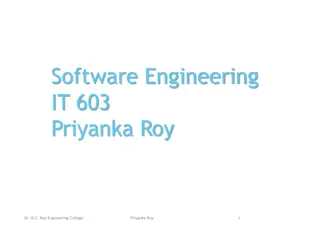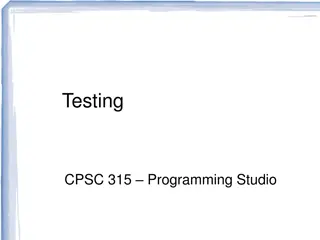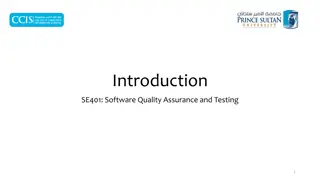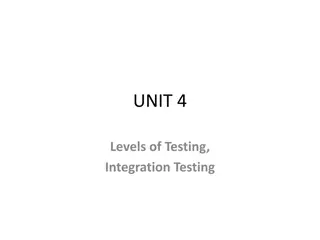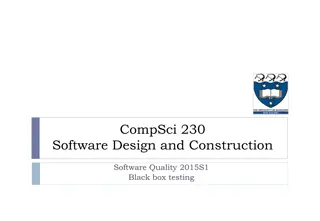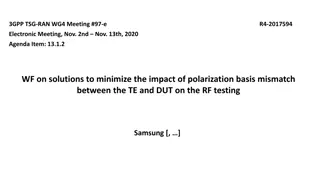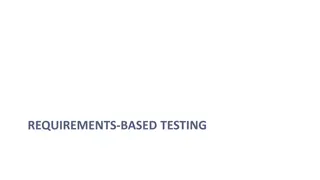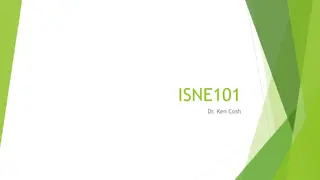Software Testing Fundamentals - Objectives, Principles, and Testability
Testing in software engineering is a critical process that aims to uncover errors in a program. This article discusses the objectives of testing, principles guiding effective test case design, and the importance of testability in software systems. Key points include the significance of traceability to customer requirements, planning testing early, and the role of independent testing parties. Understanding testability leads to the creation of more efficient and reliable test cases in software development.
Download Presentation

Please find below an Image/Link to download the presentation.
The content on the website is provided AS IS for your information and personal use only. It may not be sold, licensed, or shared on other websites without obtaining consent from the author. Download presentation by click this link. If you encounter any issues during the download, it is possible that the publisher has removed the file from their server.
E N D
Presentation Transcript
SOFTWARE ENGINEERING UNIT : IV - SOFTWARE TESTING DATE : 16.11.2020 DAY ORDER : II PRESENTED BY PROF. M. ABDULLAH ASSOCIATE PROFESSOR DEPT. COMPUTER OF COMPUTER SCIENCE JMC,TIRUCHIRAPPALLI - 20
SOFTWARE TESTING FUNDAMENTALS Testing presents an interesting anomaly for the software engineer. During earlier software engineering activities, the engineer attempts to build software from an abstract concept to a tangible product. In fact, testing is the one step in the software process that could be viewed (psychologically, at least) as destructive rather than constructive. Here, we discuss about the following:- 1. Testing Objectives 2. Testing Principles 3. Testability
Testing Objectives:- Testing is a process of executing a program with the intent of finding an error. A good test case is one that has a high probability of finding an as-yet undiscovered error. A successful test is one that uncovers an as-yet- undiscovered error. If testing is conducted successfully ( according to objectives stated previously) it will uncover errors in the software.
Testing Principles Before applying methods to design effective test cases, a software engineer must understand the basic principles that guide software testing. All tests should be traceable to customer requirements. The objective of software testing is to uncover errors. The most severe defects are those cause the program to fail to meet its requirements. Tests should be planned long before testing begins. The Pareto principle applies to software testing. Stated simply, the Pareto principle implies that 80 percent of all errors uncovered during testing will likely be traceable to 20 percent of all program components. The problem, of course, is to isolate these suspect components and to thoroughly test them.
Testing should begin in the small and progress toward testing in the large. The first tests planned and executed generally focus on individual components. Exhaustive testing is not possible. It is impossible to execute every combination of paths during testing. adequately cover program logic and to ensure that all conditions in the component level design have been exercised. To be most effective, conducted by an independent third party. It is possible to a testing should be
Testability Software testability is the degree to which a software system / software module / software requirement or design supports testing in a given test context. A software engineer designs a computer program , a system or a product with testability enables the individuals changed with testing to design effective test cases more easily. The following are the characteristics that lead to testable software. They are:- document which this
Operability means The better it works, the more efficiently it can be tested. Observability means what you see is what you test. Distinct output is generated for each input. Incorrect output is easily identified. Internal errors are automatically reported. Source code is accessible. Controllability It means "The better we can control the software, more the testing can be automated optimized." All code is executable through some combination of input. Input and output formats are consistent and structure. Test can conveniently reproduced. specified, automated and
Decomposability means "By controlling the scope of testing, you can more problems and perform smarter retesting." The software system is built from independent modules. Software modules can be tested independently. Simplicity means "The less there is to test, the more quickly we can test it. Code simplicity : For example, a coding is standard is adopted for ease of inspection and maintenance. quickly isolate
Stability means "The fewer the changes, the fewer the disruptions to testing. Changes to the software are infrequent. Changes to the software are controlled. Changes to the software do not invalidate existing tests. Understandability means we have, the smarter we will test." Changes to the design are communicated to testers. Technical documentation is instantly accessible. Technical documentation is well organized. Technical documentation is specified and detailed. Technical documentation is accurate. "The more information
Attributes of a good test:- A good test has a high probability of finding an error. To achieve this goal, the tester must understand the software and attempt to develop a mental picture of how the software might fail. A good test is not redundant. Testing time and resources are limited. There is no point in conducting a test that has the same purpose as another test. A good test should be best of breed . In a group of tests that have a similar intent, time and resource limitations may mitigate toward the execution of only a subset of these tests. A good test should be neither too simple nor too complex.
WHITE BOX TESTING White-box testing, sometimes called glass-box testing is a test case design method that uses the control structure of the procedural design to derive test cases. White box testing techniques analyze the internal structures used data structures, internal design, code structure and the working of the software rather than just the functionality as in black box testing. White box testing methods are reduce the delay between the injection of a defect in the program code and its detection.
It is also called glass box testing or clear box testing or structural testing. Using white-box testing methods, the software engineer can derive test cases that Guarantee that all independent paths within a module have been exercised at least once. Exercise all logical decisions on their true and false sides. Execute all loops at their boundaries and within their operational bounds. Exercise internal data structures to ensure their validity. Logic errors and incorrect assumptions are inversely proportional to the probability that a program path will be executed. We often believe that a logical path is not likely to be executed
White Box Testing techniques:- Statement coverage: In this technique, the aim is to traverse all statement at least once. Hence, each line of code is tested. In case of a flowchart, every node must be traversed at least once. Since all lines of code are covered, helps in pointing out faulty code. Branch Coverage: In this technique, test cases are designed so that each branch from all decision points is traversed at least once. In a flowchart, all edges must be traversed at least once.
Condition Coverage: In this technique, all individual conditions must be covered as shown in the following example: a. READ X, Y b. IF(X == 0 || Y == 0) c. PRINT 0 In this example, there are 2 conditions: X == 0 and Y == 0. Now, test these conditions get TRUE and FALSE as their values. One possible example would be: #TC1 X = 0, Y = 55 #TC2 X = 5, Y = 0
Multiple Condition Coverage: In this technique, all the possible combinations of the possible outcomes of conditions are tested at least once. Let s consider the following example: a. READ X, Y b. IF(X == 0 || Y == 0) c. PRINT 0 #TC1: X = 0, Y = 0 #TC2: X = 0, Y = 5 #TC3: X = 55, Y = 0 #TC4: X = 55, Y = 5 Hence, four test cases required for two individual conditions. Similarly, if there are n conditions then 2n test cases would be required.
Advantages of White box testing:- White box testing is very thorough as the entire code and structures are tested. It results in the optimization of code removing error and helps in removing extra lines of code. It can start at an earlier stage as it doesn t require any interface as in case of black box testing. Easy to automate.
Disadvantages of White box testing:- Main disadvantage expensive. Redesign of code and rewriting code needs test cases to be written again. Testers are required knowledge of the code and programming language as opposed to black box testing. Missing functionalities cannot be detected as the code that exists is tested. Very complex and at times not realistic. is that it is very to have in-depth
BASIS PATH TESTING Basis path testing is a white-box testing technique first proposed by Tom McCabe. The basis path method enables the test case designer to derive a logical complexity measure of a procedural design and use this measure as a guide for defining a basis set of execution paths. Test cases derived to exercise the basis set are guaranteed to execute every statement in the program at least one time during testing. There are four different basis path testing techniques. Flow graph notation Cyclomatic complexity Deriving test cases Graph matrices
Flow graph notation:- A simple notation for the representation of control flow, called a flow graph (or program graph) must be introduced. The flow graph depicts logical control flow using the notation. Cyclomatic complexity:- Cyclomatic complexity is software metric that provides a quantitative measure of the logical complexity of a program. Cyclomatic complexity defines the number of independent paths in the basis set of a program and provides us with an upper bound for the number of tests that must be conducted to ensure that all statements have been executed at least once.
An independent path is any path through the program that introduces a least one new set of processing statements or a new condition. Cyclomatic Complexity is computed in one of three ways: The number of regions corresponds to the cyclomatic complexity. Cyclomatic complexity, V(G), for a flow graph, G, is defined as V(G) = E N + 2 where E is the number of flow graph edges, N is the number of flow graph nodes. Cyclomatic complexity, V(G), for a flow graph, G, is also defined as V(G) = P + 1 where P is the number of predicate nodes contained in the flow graph G. of the flow graph
A predicate node is a node that connects two or more edges. The cyclomatic complexity can be computed using each of the algorithms just noted: 2. V(G) = 11 edges - 9 nodes + 2 = 4. 3. V(G) = 3 predicate nodes + 1 = 4. Deriving Test cases:- The basis path testing method can be applied to a procedural design or to source code. The following steps can be applied to derive the basis set: 1. Using the design or code as a foundation, draw a corresponding flow graph.
2. Determine the cyclomatic complexity of the resultant flow graph. 3. Determine a basis set of linearly independent paths. 4. Prepare test cases that will force execution of each path in the basis set. Graph Matrices:- To develop a software tool that assists in basis path testing, a data structure, called a graph matrix, can be quite useful. A graph matrix is a square matrix whose size (i.e., number of rows and columns) is equal to the number of nodes on the flow graph. Each row and column corresponds to an identified node, and matrix entries correspond to connections (an edge) between nodes. Each letter has been replaced with a 1, indicating that a connection exists (zeros have been excluded for clarity). Represented in this form, the graph matrix is called a connection matrix.
CONTROL STRUCTURE TESTING Control structure testing is used to increase the coverage area by testing various control structures present in the program. The different types of testing performed under control structure testing are as follows:- 1. Condition Testing 2. Data Flow Testing 3. Loop Testing Condition testing:- Condition testing is a test cased design method, which ensures that the logical condition and decision statements are free from errors. The errors present in logical conditions can be incorrect Boolean operators, missing parenthesis in a Boolean expression, error in relational operators, arithmetic expressions, and so on.
A relational expression takes the form E1 <relational-operator> E2 Where E1 and E2 are arithmetic expressions and <relational-operator> is one of the following: <, , =, (non equality), >, or . A compound condition is composed of two or more simple conditions, Boolean operators, and parentheses. We assume that Boolean operators allowed in a compound condition include OR (|), AND (&) and NOT ( ). A condition without relational expressions is referred to as a Boolean expression. The types of errors in a condition include the following:- Boolean operator error (incorrect/missing/extra Boolean operators). Boolean variable error.
Boolean parenthesis error. Relational operator error. Arithmetic expression error. Example-1:- C1 : B1 & B2 Where B1 & B2 are Boolean variables. Example-2:- C2 : B1 & (E3 = E4) Where B1 is a Boolean expressions and E3 and E4 are Arithmetic expressions. Example-3:- C3: (E1 > E2) & (E3 = E4) Where E1, E2, E3, and E4 are Arithmetic expressions.
Data Flow Testing:- The data flow test method chooses the test path of a program based on the locations of the definitions and uses all the variables in the program. For example, with S as its statement number. DEF (S) = {X | Statement S has a definition of X} USE (S) = {X | Statement S has a use of X} Loop Testing: - Loop testing is actually a white box testing technique. It specifically focuses on the validity of loop construction. Following are the types of loops:- a) Simple Loop The following set of test can be applied to simple loops, where the maximum allowable number through the loop is n. Skip the entire loop. Traverse the loop only once. Traverse the loop two times. Make p passes through the loop where p<n. Traverse the loop n-1, n, n+1 times.
b) Concatenated Loops If loops are not dependent on each other, concatenated loops can be tested using the approach used in simple loops. if the loops are interdependent, the steps are followed in nested loops. c) Nested Loops Loops within loops are called as nested loops. When testing nested loops, the number of tested increases as level nesting increases. The following steps for testing nested loops are as follows-: (i) Start with inner loop. Set all other loops to minimum values. (ii) Conduct simple loop testing on inner loop. (iii) Work outwards. (iv) Continue until all loops tested. d) Unstructured loops This type of loops should be redesigned, whenever possible, to reflect the use of unstructured the structured programming constructs.








